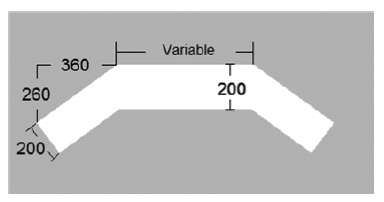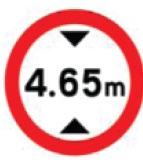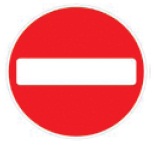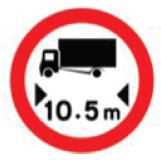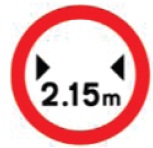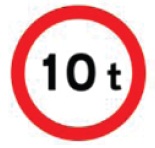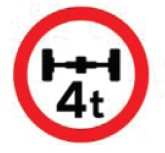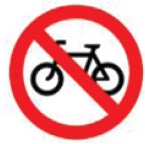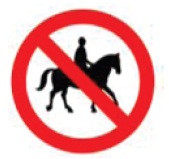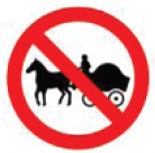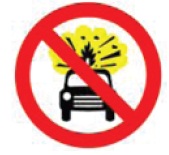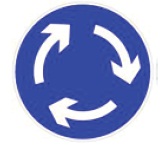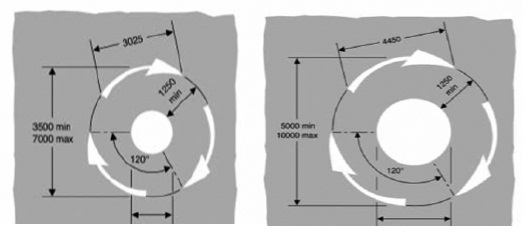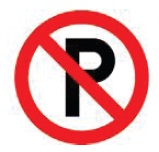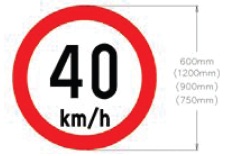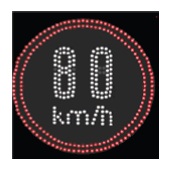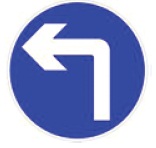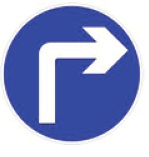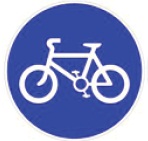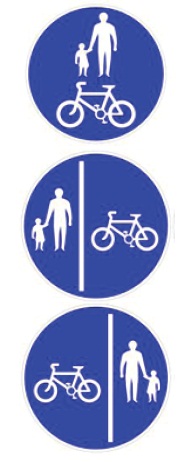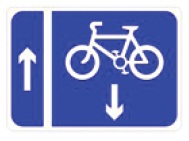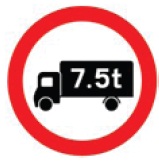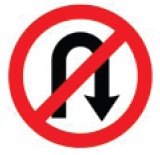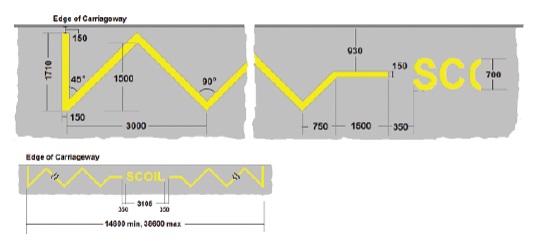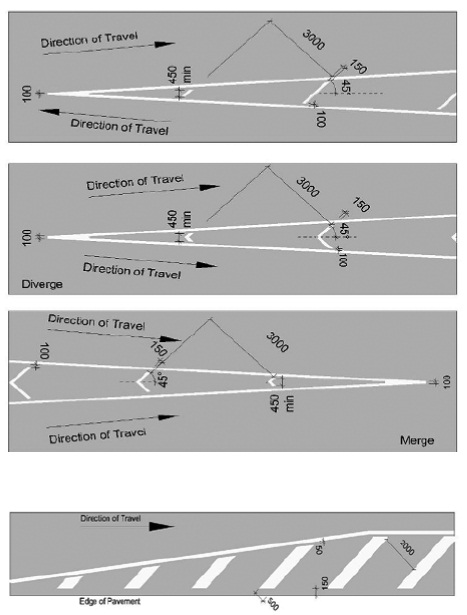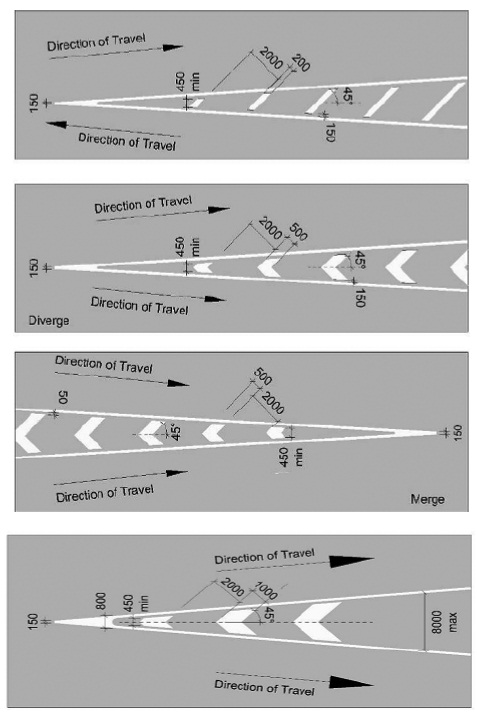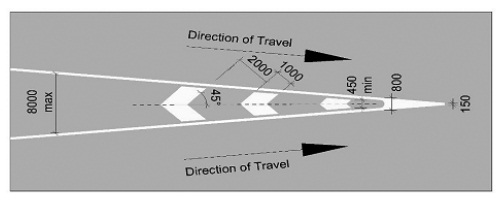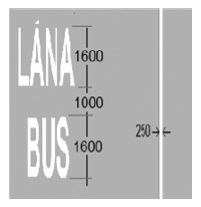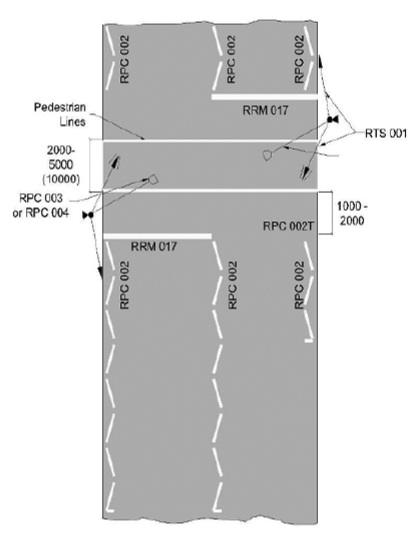S.I. No. 331/2012 - Road Traffic (Signs) (Amendment) Regulations 2012.
CONTENTS | ||
Part 1 | ||
Preliminary and General | ||
1. Citation, collective citation and commencement | ||
2. Interpretation | ||
3. Revocation | ||
Part 2 | ||
Regulatory Traffic Signs — upright | ||
4. Vehicle height restriction | ||
5. Prohibition on entry to vehicles | ||
6. Maximum vehicle length | ||
7. Maximum vehicle width | ||
8. Maximum design gross vehicle weight (safety) | ||
9. Maximum vehicle axle loading weight | ||
10. Prohibition on pedal cycles | ||
11. Prohibition on animals | ||
12. Prohibition on animal-drawn vehicles | ||
13. Prohibition on vehicles carrying explosive material (road tunnel) | ||
Part 3 | ||
Regulatory Traffic Signs — upright and roadway markingMini-roundabout signs | ||
14. Mini-roundabout — upright sign | ||
15. Mini-roundabout — roadway marking | ||
Part 4 | ||
Application of section 36A Bye-laws for restriction on parking — specified events | ||
16. Restriction on parking sign — specified events | ||
Part 5 | ||
Speed Limit Signs | ||
17. Speed limit sign — 40 km/h | ||
18. Variable special speed limit sign | ||
Part 6 | ||
Variable Message Sign — traffic lane control | ||
19. Traffic lane control — variable message sign | ||
Part 7 | ||
Amendment of Principal Regulations and other Regulations | ||
20. Definitions — the Principal Regulations | ||
21. Traffic signs | ||
22. Roadway markings | ||
23. Traffic signals | ||
24. Pedestrian crossings | ||
25. Signs and markings for bus stops | ||
26. Amendment of First Schedule | ||
27. Amendment of Second Schedule | ||
28. Amendment of Fourth Schedule | ||
29. Amendment of Seventh Schedule | ||
30. Amendment of Eighth Schedule | ||
31. Revocation of Ninth Schedule | ||
32. Amendment of Schedule 6 to S.I. No. 97 of 2003 | ||
33. Amendment of Schedule to S.I. No. 10 of 2005 | ||
34. Amendment of Regulations of 2006 | ||
Schedule 1 | ||
Regulatory Traffic Signs — upright | ||
Schedule 2 | ||
Part 1 | ||
Regulatory Traffic Signs — upright and roadway marking Mini-roundabout | ||
Part 2 | ||
Restriction on Parking Sign — specified events | ||
Part 3 | ||
Speed Limit Signs | ||
Schedule 3 | ||
Part 1 | ||
Alternative Mandatory Traffic Signs | ||
Part 2 | ||
Amendments to the Second Schedule to the Principal Regulations | ||
Part 3 | ||
Alternative traffic sign design and dimensions | ||
School Entrance — roadway markings to indicate school entrance, at which part of the roadway, the stopping or parking of a vehicle is prohibited | ||
Part 4 | ||
Alternative traffic sign designs and dimensions | ||
Merging and Diverging Marking | ||
Part 5 | ||
Traffic sign design and dimensions — bus lane | ||
Schedule 4 | ||
Alternative traffic sign design and dimensions | ||
Pedestrian Crossing Complex | ||
S.I. No. 331 of 2012 | ||
ROAD TRAFFIC (SIGNS) (AMENDMENT) REGULATIONS 2012 | ||
Notice of the making of this Statutory Instrument was published in | ||
“Iris Oifigiúil” of 7th September, 2012. | ||
I, LEO VARADKAR, Minister for Transport, Tourism and Sport, in exercise of the powers conferred on me by section 86 and section 95 (as amended by section 78 of the Road Traffic Act 2010 (No. 25 of 2010)) of the Road Traffic Act 1961 (No. 24 of 1961), and the National Roads and Road Traffic (Transfer of Departmental Administration and Ministerial Functions) Order 2002 ( S.I. No. 298 of 2002 ) (as adapted by the Transport (Alteration of Name of Department and Title of Minister) Order 2011 ( S.I. No. 141 of 2011 )), hereby make the following regulations: | ||
PART 1 | ||
Preliminary and General | ||
Citation, collective citation and commencement | ||
1. (1) These Regulations may be cited as the Road Traffic (Signs) (Amendment) Regulations 2012. | ||
(2) The Road Traffic (Signs) Regulations 1997 to 2011 and these Regulations may be cited together as the Road Traffic (Signs) Regulations 1997 to 2012. | ||
(3)(a) These Regulations, other than the provisions mentioned in subparagraphs (b) and (c) come into operation on 1 October 2012. | ||
(b) Regulations 5 to 15 come into operation on 1 May 2013. | ||
(c) Regulation 27(a) comes into operation on 1 October 2013. | ||
Interpretation | ||
3. In these Regulations— | ||
“Act of 1994” means Road Traffic Act 1994 (No. 7 of 1994); | ||
“Act of 2004” means Road Traffic Act 2004 (No. 44 of 2004); | ||
“m” appearing on any sign represents one metre; | ||
“Principal Regulations” means Road Traffic (Signs) Regulations 1997 ( S.I. No. 181 of 1997 ); | ||
“Regulations of 1998” means Road Traffic (Signs) (Amendment) Regulations 1998 ( S.I. No. 273 of 1998 ); | ||
“Regulations of 2006” means Road Traffic (Signs) Regulations 2006 ( S.I. No. 637 of 2006 ); | ||
“t” appearing on any sign represents one tonne. | ||
Revocation | ||
3. The Road Traffic (Signs) (Amendment) Regulations 2011 ( S.I. No. 672 of 2011 ) are revoked. | ||
PART 2 | ||
Regulatory Traffic Signs — upright | ||
Vehicle height restriction | ||
4. (1) Traffic sign number RUS 016 (vehicle height restriction) shall, when provided on or in the vicinity of a structure— | ||
(a) indicate the height of the structure for the purposes of Part 17 of the Railway Safety Act 2005 (No. 31 of 2005), and | ||
(b) consist of— | ||
(i) a white disc with a red border displaying, in black, one arrowhead symbol above and a second one beneath figures associated with the unit “m”, signifying height, in metres, or | ||
(ii) the dimensions and design set out for traffic sign number RUS 016 (Height Restriction) in the Second Schedule to the Principal Regulations. | ||
(2) The dimensions and design of the traffic sign described in paragraph (1)(b)(i) are set out in Schedule 1. | ||
(3) In this Regulation “structure” has the meaning assigned to it by section 138 of the Railway Safety Act 2005 . | ||
Prohibition on entry to vehicles | ||
5. (1) Traffic sign number RUS 050 (no entry to vehicles) shall, when provided at the entrance to a road— | ||
(a) indicate that a driver of a vehicle shall not proceed beyond the sign, and | ||
(b) consist of a red disc with a horizontal white bar. | ||
(2) The dimensions and design of traffic sign number RUS 050 are set out in Schedule 1. | ||
Maximum vehicle length | ||
6. (1) Traffic sign number RUS 051 (maximum vehicle length) shall— | ||
(a) indicate that the driver of a vehicle or combinations of vehicles, the overall length of which exceeds the length specified on the sign, shall not proceed beyond the sign, and | ||
(b) consist of a white disc with a red border displaying in black on the disc, a symbol of a long vehicle and beneath it, 2 arrowhead symbols and figures associated with the unit “m”, signifying that the maximum length of the vehicle or combination of vehicles must not exceed the length, in metres, specified on the sign. | ||
(2) The dimensions and design of traffic sign number RUS 051 are set out in Schedule 1. | ||
Maximum vehicle width | ||
7. (1) Traffic sign number RUS 052 (maximum vehicle width) shall— | ||
(a) indicate that the driver of a vehicle, the width of which exceeds the width specified on the sign shall not proceed beyond the sign, and | ||
(b) consist of a white disc with a red border displaying, in black, 2 arrowhead symbols and beneath these, figures associated with the unit “m”, signifying that the maximum width of a vehicle must not exceed the width, in metres, specified on the sign. | ||
(2) The dimensions and design of traffic sign number RUS 052 are set out in Schedule 1. | ||
Maximum design gross vehicle weight (safety) | ||
8. (1) Traffic sign number RUS 053 (maximum design gross vehicle weight (safety)) shall— | ||
(a) indicate that the driver of a vehicle, the design gross vehicle weight of which exceeds the weight specified on the sign, shall not proceed beyond the sign, and | ||
(b) consist of a white disc with a red border displaying, in black, figures associated with the unit “t” signifying that the design gross vehicle weight of a vehicle must not exceed the weight, in tonnes, specified on the sign. | ||
(2) The dimensions and design of traffic sign number RUS 053 are set out in Schedule 1. | ||
Maximum vehicle axle loading weight | ||
9. (1) Traffic sign number RUS 054 (maximum vehicle axle loading weight) shall— | ||
(a) indicate that the driver of a vehicle, the vehicle axle loading weight of which exceeds the weight specified on the sign, shall not proceed beyond the sign, and | ||
(b) consist of a white disc with a red border displaying, in black, a symbol depicting a vehicle axle and beneath it figures associated with the unit “t”, signifying that the maximum axle loading weight of a vehicle must not exceed the weight, in tonnes, specified on the sign. | ||
(2) The dimensions and design of traffic sign number RUS 054 are set out in Schedule 1. | ||
Prohibition on pedal cycles | ||
10. (1) Traffic sign number RUS 055 (no pedal cycles) shall, when provided on a public road— | ||
(a) indicate that a person driving a pedal cycle shall not proceed beyond the sign, and | ||
(b) consist of a white disc with a red border containing an oblique red bar and, in black, a symbol of a pedal cycle. | ||
(2) The dimensions and design of traffic sign number RUS 055 are set out in Schedule 1. | ||
Prohibition on animals | ||
11. (1) Traffic sign number RUS 056 (no animals) shall— | ||
(a) indicate that a person who is riding, leading or driving a horse or animal, or who is in charge of a horse or animal, on the road shall not proceed beyond the sign, and | ||
(b) consist of a white disc with a red border containing an oblique red bar and, in black, a symbol depicting a person riding a horse. | ||
(2) The dimensions and design of traffic sign number RUS 056 are set out in Schedule 1. | ||
(3) In this Regulation “animal” does not include a cat or a dog. | ||
Prohibition on animal-drawn vehicles | ||
12. (1) Traffic sign number RUS 057 (no animal-drawn vehicles) shall— | ||
(a) indicate that a person driving or in charge of an animal-drawn vehicle shall not proceed beyond the sign, and | ||
(b) consist of a white disc with a red border containing an oblique red bar and, in black, a symbol depicting a person driving an animal-drawn vehicle. | ||
(2) The dimensions and design of traffic sign number RUS 057 are set out in Schedule 1. | ||
Prohibition on vehicles carrying explosive material (road tunnel) | ||
13. (1) Traffic sign number RUS 062 (no vehicles carrying explosive material) (road tunnel)) shall, when provided at or near the entrance to a road tunnel— | ||
(a) indicate that the driver of a vehicle or of any vehicle being drawn by a vehicle carrying explosive materials shall not proceed beyond the sign, and | ||
(b) consist of a white disc with a red border containing an oblique red bar and, in black, a symbol depicting the occurrence of an explosion in a vehicle. | ||
(2) The dimensions and design of traffic sign number RUS 062 are set out in Schedule 1. | ||
(3) In this Regulation “explosive material” means any article or substance which as presented for transport is liable to or would reasonably be expected to explode, dangerously react, produce a flame or dangerous evolution of heat, or produce dangerous emissions of toxic, corrosive or flammable gases or vapours, in each case, under normal conditions of transport. | ||
PART 3 | ||
Regulatory Traffic Signs — upright and roadway marking Mini-roundabout signs | ||
Mini-roundabout — upright sign | ||
14. (1) Traffic sign number RUS 049 (mini-roundabout sign) shall— | ||
(a) indicate a mini-roundabout ahead, and | ||
(b) consist of a blue disc with a white border containing 3 directional arrows, in white, indicating the direction in which traffic must proceed on entering the mini-roundabout. | ||
(2) The dimensions and design of traffic sign number RUS 049 are set out in Part 1 of Schedule 2. | ||
Mini-roundabout — roadway marking | ||
15. (1) Traffic sign number RRM 033 (mini-roundabout — roadway marking sign) shall— | ||
(a) indicate the location of a mini-roundabout on the roadway, and | ||
(b) consist of 3 directional arrows, in white, surrounding a central white disc, indicating the direction in which traffic must proceed on entering the mini-roundabout. | ||
(2) The dimensions and design of traffic sign number RRM 033 are set out in Part 1 of Schedule 2. | ||
PART 4 | ||
Application of section 36A Bye-laws for restriction on parking — specified events | ||
Restriction on parking sign — specified events | ||
16. (1) Traffic sign number RUS 063 (restriction on parking sign — specified events) shall, when provided on a public road or on all public roads at the entrance to an area— | ||
(a) indicate to the drivers of mechanically propelled vehicles that bye-laws have been made under section 36A (inserted by section 12 of the Roads Act 2007 (No. 34 of 2007)) of the Act of 1994 (in this Regulation referred to as “section 36A bye-laws”) and apply a prohibition or restriction on the parking of vehicles on that public road or on all public roads within a specified area, and | ||
(b) consist of a white disc with a red border containing an oblique red bar and, in black, the letter “P” and is accompanied by an information plate showing details regarding the date or day and period of the operation of the section 36A bye-laws, to signify that a prohibition or restriction on the parking of mechanically propelled vehicles applies. | ||
(2) The dimensions and design of traffic sign number RUS 063 are set out in Part 2 of Schedule 2. | ||
(3) Traffic sign number RUS 063 shall be provided accompanied by an information plate specifying the word “END/Críoch” instead of the information plate referred to in sub-paragraph (b), to indicate to the drivers of mechanically propelled vehicles facing that sign that the section 36A bye-laws do not apply on the public road past that sign. | ||
PART 5 | ||
Speed Limit Signs | ||
Speed limit sign — 40 km/h | ||
17. (1) A speed limit sign, traffic sign number RUS 064 (speed limit sign — 40 km/h) shall consist of a white disc with a red border containing— | ||
(a) in black, the figures “40”, and | ||
(b) beneath those figures, in black letters “km/h”. | ||
(2) The dimensions and design of the sign to traffic sign number RUS 064 are set out in Part 3 of Schedule 2. | ||
(3) A speed limit sign, in accordance with paragraph (1), may be provided by a county or a city council to indicate the locations within its administrative area where a special speed limit made under section 9(1) of the Act of 2004 applies or may be provided to indicate the locations where a road works speed limit order made by the manager of a county or city council under section 10 of the Act of 2004 applies. | ||
(4) In this Regulation “speed limit sign” means a traffic sign indicating— | ||
(a) the existence of special speed limit bye-laws made under section 9(1) of the Act of 2004 applying a special speed limit of 40 kilometres per hour, or | ||
(b) that a road works speed limit order has been made under section 10 of the Act of 2004 applying a road works speed limit of 40 kilometres per hour. | ||
Variable special speed limit sign | ||
18. (1) A variable special speed limit sign, traffic sign number RVMS 102 (variable special speed limit sign) may be provided on a national road or motorway or any part, carriageway or lane of a national road or motorway except at a location where traffic sign number RVMS 100 (road tunnel speed limit sign) is provided and shall— | ||
(a) indicate, when illuminated, that the special speed limit displayed on the sign is the speed limit that applies to the national road or motorway or any part, carriageway or lane of the national road or motorway in lieu of the speed limit that normally applies, and | ||
(b) consist of a black disc which, when illuminated, displays a red border enclosing the disc and displaying in white figures, the special speed limit applying, and beneath those figures, in white letters “km/h”. | ||
(2) Traffic sign number RVMS 102 shall be lighted and extinguished by the road authority or its agent using an automatic or manually operated device, as and when required, to display the special speed limit applying. | ||
(3) The dimensions and design of traffic sign number RVMS 102 are set out in Part 3 of Schedule 2. | ||
(4) A variable special speed limit sign, in accordance with paragraph (1), may be provided, except at a location where traffic sign number RVMS 100 (road tunnel speed limit sign) is provided, by a county council or a city council to indicate the locations on a national road or motorway or any part, carriageway or lane of a national road or motorway within its administrative area where a special speed limit made for the purposes of section 9(6) of the Act of 2004 applies. | ||
(5) Traffic sign number RVMS 100 (road tunnel speed limit sign) is a traffic sign that is prescribed in Regulation 3 of the Regulations of 2006. | ||
(6) In this Regulation “variable special speed limit sign” means a traffic sign indicating the existence of special speed limit bye-laws made for the purposes of section 9(6) of the Act of 2004. | ||
PART 6 | ||
Variable Message Sign — traffic lane control | ||
Traffic lane control — variable message sign | ||
19. (1) Traffic sign number RVMS 101 (traffic lane control sign — variable message) may be provided at a location other than that to which Regulation 3 of the Road Traffic (Control of Traffic) Regulations 2006 ( S.I. No. 638 of 2006 ) and Regulation 4 of the Regulations of 2006 refer and shall, when provided above a traffic lane indicate to traffic in the traffic lane either that traffic must stop or the direction in which traffic must proceed. | ||
(2) Paragraphs (2) to (8) of Regulation 4 of the Regulations of 2006 apply to traffic sign number RVMS 101 where it is provided under paragraph (1) and the dimensions and design of this traffic sign are set out in Part 2 of Schedule 1 to the Regulations of 2006. | ||
PART 7 | ||
Amendment of the Principal Regulations and other Regulations | ||
Definitions — the Principal Regulations | ||
20. The Principal Regulations are amended in article 3(1) (as amended by article 4 of the Regulations of 1998)— | ||
(a) by inserting after the definition of “the Act of 1994” the following: | ||
“ ‘Act of 2010’ means the Road Traffic Act 2010 (No. 25 of 2010);”, | ||
(b) by substituting for the definition of “bus stop sign” the following: | ||
“ ‘bus stop sign’ means a sign to indicate a stopping place or stand for large public service vehicles or omnibuses provided under, or in pursuance of, section 86 of the Act of 1961 or section 35 of the Act of 1994;”, | ||
(c) by inserting after the definition of “design” the following: | ||
“ ‘design gross vehicle weight’ has the meaning assigned to it by section 2(1) of the Road Traffic (Construction and Use of Vehicles) Regulations 2003 ( S.I. No. 5 of 2003 );”, | ||
(d) by substituting for the definition of “disc parking place” the following: | ||
“ ‘disc parking place’ means a place on a public road where the parking of vehicles is subject to the exhibition of a document or other format in accordance with bye-laws made under section 36 of the Act of 1994;”, | ||
(e) by inserting after the definition of “loading bay” the following: | ||
“ ‘m’ appearing on any sign represents one metre;”, | ||
(f) by substituting for the definition of “meter parking place” the following: | ||
“ ‘meter parking place’ means a place on a public road where the parking of vehicles is subject to the payment of fees by means of parking meters or other modes of pay and display;”, and | ||
(g) by substituting for the definition of “traffic sign” the following: | ||
“ ‘traffic sign’ has the meaning assigned to it by section 95 (as amended by section 78 of the Act of 2010) of the Act of 1961;”. | ||
Traffic Signs | ||
21. The Principal Regulations are amended— | ||
(a) by substituting for article 5 the following: | ||
“Mandatory signs | ||
5. (1) Subject to sub-article (3), a mandatory traffic sign shall consist of a blue disc with a white border and appropriate symbols shown in white on the disc, and shall indicate— | ||
(a) the direction or route in which traffic mustproceed, or | ||
(b) a cycle track. | ||
(2) The following shall be as set out in the First Schedule— | ||
(a) the dimensions and designs of signs to which this article applies, | ||
(b) the symbols to be used on such signs, | ||
(c) the sign numbers applying to such signs. | ||
(3) Mandatory traffic signs may consist of a blue rectangle with a white border and appropriate symbols shown in white on the plate where such design is provided for in these Regulations. | ||
(4) A mandatory traffic sign may be displayed in a variable message sign format and, at a place where roadworks are being carried out, traffic sign numbers RUS 001, RUS 002 or RUS 003 may— | ||
(a) be displayed in a variable message format mounted on a roadworks vehicle that is stationary or is moving along the public road in the course of mobile roadworks operations, and | ||
(b) have a diameter greater than 1500 millimetres. | ||
With-flow cycle track sign | ||
5A.(1) Traffic sign number RUS 009 (with-flow cycle track) shall, when provided in association with traffic sign number RRM 022 (continuous white line) or traffic sign number RRM 023 (broken white line)— | ||
(a) indicate a cycle track, and | ||
(b) consist of a blue disc with a white border containing a symbol of a pedal cycle, in white. | ||
(2) The dimensions and design of traffic sign number RUS 009 are shown in either of the 2 designs for this sign as set out in the First Schedule. | ||
Shared track for use by pedestrians and cyclists sign | ||
5B.(1) Traffic sign number RUS 058 (shared track for use by pedestrians and cyclists) shall- | ||
(a) indicate a shared track for use by pedestrians and persons driving pedal cycles, and | ||
(b) consist of a blue disc with a white border displaying, in white, a symbol signifying pedestrians positioned above the symbol of a pedal cycle, to depict the use of a shared track, or, alternatively, displaying, in white, a vertical white line, displayed on the right or on the left hand-side of the disc, with a symbol signifying pedestrians on one side of the line and the symbol of a pedal cycle on the other, to depict that use of the track is divided into 2 separate areas, one for use by pedestrians and the other for use by persons driving pedal cycles as specified on the sign. | ||
(2) The dimensions and designs of traffic sign number RUS 058 are set out in the First Schedule. | ||
Contra-flow cycle track sign | ||
5C.(1) Traffic sign number RUS 059 (contra-flow cycle track) shall, when provided in association with traffic sign number RRM 022 (continuous white line)— | ||
(a) indicate a contra-flow cycle track, and | ||
(b) consist of a blue rectangular sign with a white border, displaying in white, a vertical white line to depict a traffic lane with an arrow pointing straight ahead to indicate the direction of traffic flow in that lane and to depict, next to the traffic lane, a contra-flow cycle track with the symbol of a pedal cycle and with an arrow pointing downwards to indicate that pedal cycles are being driven in a contra-flow direction to that of the traffic in the adjacent traffic lane. | ||
(2) The dimensions and design of traffic sign number RUS 059 are set out in the First Schedule.”, | ||
(b) in article 6(4) (as amended by Regulation 2 of the Road Traffic (Signs) (Amendment) Regulations 2004 ( S.I. No. 403 of 2004 )), by substituting “large public service vehicles” for “omnibuses” where it occurs in paragraphs (a) and (c), | ||
(c) by substituting for article 9 the following: | ||
“Bus lanes | ||
9. (1) Traffic sign numbers RUS 028 or RUS 029 shall, in association with traffic sign number RRM 024, indicate a bus lane and traffic sign number RUS 030 shall, in association with traffic sign number RRM 024, indicate a contra-flow bus lane. | ||
(2) Traffic sign numbers RUS 028, RUS 029 and RUS 030 shall consist of a blue rectangle with appropriate symbols or letters shown in white. | ||
(3) The content, design and dimensions of traffic sign numbers RUS 028, RUS 029 and RUS 030 shall be as set out in the Fifth Schedule.”. | ||
Roadway markings | ||
22. The Principal Regulations are amended— | ||
(a) by substituting for articles 11 and 12 the following: | ||
“Centre of roadway | ||
11. (1) The following traffic signs may be provided along the centre of a roadway: | ||
(a) traffic sign number RRM 001 — a continuous white line approximately 100 or 150 millimetres wide, and where traffic sign number RRM 001 is provided in association with traffic sign number RRM 017 (Stop Line) it shall not be— | ||
(i) less than 8 metres long, or | ||
(ii) less than 2 metres long on a roadway that is less than 5.3 metres wide, | ||
(b) traffic sign number RRM 002 — a broken white line extending along the centre of the roadway and consisting of segments having the following dimensions and spacings: | ||
(i) segments approximately 100 millimetres or 150 millimetres wide, approximately 3 metres long and spaced approximately 3 metres apart; | ||
(ii) segments approximately 100 millimetres or 150 millimetres wide, approximately 3 metres long and spaced approximately 9 metres apart; | ||
(iii) segments approximately 100 millimetres or 150 millimetres wide, approximately 3 metres long and spaced approximately one metre apart; | ||
(iv) segments approximately 100 millimetres or 150 millimetres wide, approximately 4 metres long and spaced approximately 2 metres apart. | ||
(2) Traffic sign number RRM 001 may be provided along a roadway other than at the centre of the roadway where it is appropriate in accordance with the layout of traffic lanes. | ||
Traffic lane | ||
12. Traffic sign number RRM 003 shall indicate— | ||
(a) the boundary of a traffic lane, and | ||
(b) consist of a broken white line consisting of segments having the following dimensions and spacing: | ||
(i) segments approximately 100 millimetres or 150 millimetres wide, approximately 2 metres long and approximately 2 metres apart; | ||
(ii) segments approximately 100 millimetres or 150 millimetres wide, approximately 4 metres long and approximately 8 metres apart; | ||
(iii) segments approximately 100 millimetres or 150 millimetres wide, approximately one metre long and approximately one metre apart, where traffic sign number RRM 003 is provided as traffic lane guidance markings in a traffic lane crossover situation.”, | ||
(b) by inserting after article 13 the following: | ||
“Temporary use of orange coloured roadway markings at roadworks | ||
13(A).Traffic sign numbers RRM 001 and RRM 002 as referred to in article 11, traffic sign number RRM 003 as referred to in article 12, traffic sign numbers RRM 004, RRM 005 and RRM 006 as referred to in article 13 and traffic sign number RRM 021 as referred to in article 25, shall be provided as orange coloured markings instead of white to indicate a place on a public road where roadworks are being carried out and temporary road markings are being provided.”, | ||
(c) by substituting for articles 14 and 15 the following: | ||
“Single yellow line | ||
14. Traffic sign number RRM 007 shall— | ||
(a) indicate that parking of vehicles is restricted at certain times on that side of the roadway, and | ||
(b) consist of a continuous yellow line approximately 50 millimetres or 100 millimetres wide extending along the edge of a roadway and situated approximately 150 millimetres or 300 millimetres from that edge. | ||
Double yellow lines | ||
15. Traffic sign number RRM 008 shall— | ||
(a) indicate that parking of vehicles is prohibited at any time on that side of the roadway, and | ||
(b) consist of 2 parallel continuous yellow lines approximately 50 millimetres or 100 millimetres apart extending along the edge of a roadway, each line being approximately 50 millimetres wide and the line nearest the edge of the roadway being situated approximately 150 millimetres from that edge or, 2 such parallel continuous yellow lines approximately 100 millimetres apart extending along the edge of a roadway, each line being approximately 100 millimetres wide and the line nearest the edge of the roadway being situated approximately 300 millimetres from that edge.”, | ||
(d) in article 17, by substituting for paragraph (b) the following: | ||
“(b) consist of the words ‘SCHOOL KEEP CLEAR’ or the word ‘SCOIL’, written in yellow on the roadway, on either side of which shall be yellow zig-zag lines.”, | ||
(e) by substituting for article 18 the following: | ||
“Parking bays | ||
18. Traffic sign numbers RRM 011, RRM 012, RRM 013, RRM 014 and RRM 016 shall— | ||
(a) indicate, in any place on a public road, parking bays, and associated buffer areas where provided, and | ||
(b) consist of roadway markings, the dimensions and design of which shall be as set out in Section 2 of the Seventh Schedule.”, | ||
(f) by substituting for article 20 the following: | ||
“Pay parking area | ||
20. (1) Traffic sign numbers RRM 011, RRM 012, RRM 013, RRM 014, RRM 015 or RRM 016 may be provided to indicate a pay parking area., | ||
(2) The dimensions and design of traffic sign number RRM 016 shall be as set out in Section 2 of the Seventh Schedule.”, | ||
(g) in article 21 (inserted by article 6 of the Regulations of 1998) by inserting after sub-article (3) the following: | ||
“(4) Where traffic sign number RRM 017 (Stop Line) is provided at a level crossing, a swing bridge or a lifting bridge where traffic sign number RTS 005 (Traffic Signals — Level Crossing) is provided, the continuous white line shall be approximately 250 millimetres or 300 millimetres wide.”, | ||
(h) by substituting for article 22 (inserted by article 7 of the Regulations of 1998) the following: | ||
“Yield line | ||
22. Traffic sign number RRM 018 shall— | ||
(a) indicate the point beyond which traffic shall not proceed, where required, in compliance with a road regulation, | ||
(b) consist of— | ||
(i) in the case of a cycle track, a broken white line consisting of segments not less than approximately 100 millimetres wide and not greater than approximately 150 millimetres wide, approximately 300 millimetres long and approximately 300 millimetres apart, and | ||
(ii) any other case, a broken white line consisting of segments not less than approximately 200 millimetres and not more than approximately 250 millimetres wide, approximately one metre long and approximately one metre apart, and extending, in the case of a one-way roadway or a cycle track, across the full width of the roadway or cycle track and, in any other case, across the roadway from the left hand edge to the centre thereof, | ||
and | ||
(c) may, at a location other than a cycle track, where the width of the traffic lane is not sufficient to display the dimensions referred to in paragraph (b)(ii), consist of a broken white line approximately 200 millimetres wide, approximately 500 millimetres long and approximately 500 millimetres apart.”, | ||
(i) by substituting for articles 24 and 25 the following: | ||
“Yellow box roadway marking | ||
24. Traffic sign number RRM 020 (yellow box roadway marking) shall— | ||
(a) indicate an area of roadway which traffic shall not enter except in compliance with a road regulation, and | ||
(b) consist of continuous yellow lines approximately 200 millimetres or 300 millimetres wide enclosing an area of roadway cross-hatched in diagonal yellow lines approximately 150 millimetres or 200 millimetres wide and approximately 1.4 metres, 2 metres or 2.5 metres apart. | ||
Merging and diverging marking | ||
25. (1) Traffic sign number RRM 021 shall indicate an area of roadway into which traffic shall not enter. | ||
(2) The dimensions and design of the sign to which sub-article (1) refers are set out in Section 3 of the Seventh Schedule.”, | ||
(j) in article 27(2), by substituting for paragraph (b) the following: | ||
“(b) lettering, in white, consisting of the words ‘LÁNA BUS’, the dimensions and design of which shall be as set out in Section 4 of the Seventh Schedule.”, | ||
(k) by substituting for articles 30 and 31 the following: | ||
“Right edge of motorway | ||
30. Traffic sign number RRM 027 shall— | ||
(a) indicate the right hand edge of the carriageway of a motorway or dual carriageway, and | ||
(b) consist of a continuous white line approximately 150 millimetres wide. | ||
Access or exit lane on motorway | ||
31. Traffic sign number RRM 028 shall— | ||
(a) indicate the boundary of an access lane or exit lane on a motorway, and | ||
(b) consist of a broken white line consisting of segments approximately 150 millimetres or 250 millimetres wide, approximately 2 metres long, and spaced approximately 2 metres apart.”, | ||
and | ||
(l) in article 32, by substituting in paragraph (b) “2.5 metres” for “2.4 metres”. | ||
Traffic signals | ||
23. The following is substituted for Part IV of the Principal Regulations: | ||
“PART IV | ||
Traffic Signals | ||
Traffic lights | ||
33. Traffic sign number RTS 001 shall consist of a set of 3 lamps which shall comply with the following conditions: | ||
(a) the lamps shall face the stream of traffic they are intended to control; | ||
(b) the lamps shall show red, amber (which may be flashing or non-flashing) and green lights when lit; | ||
(c) the lamps shall be arranged vertically, the red light, being uppermost and the green light being lowest; | ||
(d) each lamp shall be separately illuminated and the effective diameter of the lens thereof shall be either between 200 millimetres and 215 millimetres or between 300 millimetres and 315 millimetres; | ||
(e) the centre of the lens of a lamp shall be not more than 380 millimetres from that of the lamp immediately next to it; | ||
(f) each lamp shall be lighted and extinguished in turn, at intervals determined by an automatic or manually operated device; | ||
(g) the lower edge of the lowest lamp shall be not less than 2.1 metres and not more than 3.05 metres above the surface of the ground in the immediate vicinity. | ||
Temporary traffic lights | ||
33A.Where traffic sign number RTS 001 is provided at a place where roadworks are being carried out or, for other temporary traffic management purposes, it shall consist of a set of 3 lamps which shall comply with the conditions set out in paragraphs (a) to (f) of article 33 and the lower edge of the lowest lamp shall not be less than 1.1 metres and not more than 3.05 metres above the surface of the ground in the immediate vicinity. | ||
Traffic lights — directional arrows, bus or U-turn display | ||
34. Traffic sign number RTS 002 shall consist of a set of 3 lamps which shall— | ||
(a) comply with the conditions set out in paragraphs (a), (d), (e), (f) and (g) of article 33, | ||
(b) be arranged vertically, the lamp showing the red display being uppermost and that showing the green display being lowest, and | ||
(c) show one of the following: | ||
(i) a red light, an amber light (which may be flashing or non-flashing) and a green directional arrow on a black background, respectively, when lit; | ||
(ii) the word ‘BUS’ in red on a black background, the word ‘BUS’ in amber on a black background and the word ‘BUS’ in green on a black background, respectively, when lit, when the traffic sign is intended to control the stream of traffic that is using a bus lane; | ||
(iii) a symbol of a U-Turn arrow in red on a black background, a symbol of a U-Turn arrow in amber on a black background and a symbol of a U-Turn arrow in green on a black background, respectively, when lit, when the traffic sign is intended to control a stream of traffic at a location where drivers of vehicles are permitted to make a U-Turn manoeuvre; | ||
(iv) a directional arrow in red on a black background, a directional arrow in amber on a black background and a directional arrow in green on a black background, respectively, when lit, to control the stream of traffic facing the traffic sign that wishes to proceed in the direction indicated by the arrows displayed. | ||
Traffic lights — 4 lamps including directional green arrow or bus display | ||
35. Traffic sign number RTS 003 shall consist of a set of 4 lamps, 3 of which shall comply with the conditions set out in article 33 or article 34(c)(i), and the fourth of which shall— | ||
(a) comply with the conditions set out in paragraphs (a), (d), (e) and (f) of article 33, | ||
(b) be placed beside or below the lowest lamp referred to in article 33 or article 34(c)(i), and | ||
(c) show— | ||
(i) a directional arrow in green on a black background, when lit, or | ||
(ii) the word ‘BUS’ in green on a black background, when lit, | ||
and the lower edge of the lowest lamp shall not be less than 2.1 metres and not more than 3.05 metres above the surface of the ground in the immediate vicinity. | ||
Traffic lights — 5 lamps including a directional green arrow and bus display | ||
35A.Traffic sign number RTS 013 shall consist of a set of 5 lamps which shall comply with the conditions set out in paragraphs (a), (b), (d) and (e) of article 33 and with the following conditions: | ||
(a) 3 of the lamps shall show red, amber and green lights, respectively, when lit, the fourth lamp shall show, when lit, the word ‘BUS’ in green on a black background and the fifth lamp shall show, when lit, a directional arrow in green on a black background; | ||
(b) 4 of the lamps shall be arranged vertically, the red light being uppermost, the amber lamp beneath it, the green lamp beneath the amber one and the lamp showing the word ‘BUS’ in green on a black background, when lit, being lowest and the fifth lamp showing a directional arrow in green on a black background, when lit, shall be placed beside the lowest lamp referred to in this paragraph. | ||
Directive traffic lights | ||
36. Traffic sign number RTS 004 shall consist of a set of 3 lamps which shall comply with the conditions set out in paragraphs (a), (d), (f) and (g) of article 33 and with the following conditions: | ||
(a) the lamps shall show a red light, an amber light and a flashing directional arrow in amber, respectively, when lit, or alternatively show, a directional arrow in red, a directional arrow in amber or a flashing directional arrow in amber on black backgrounds, respectively, when lit; | ||
(b) the lamps shall be arranged vertically, that showing a red light when lit being uppermost and that showing a flashing directional arrow in amber being lowest or, alternatively that showing a directional arrow in red, when lit, being uppermost and that showing a flashing directional arrow in amber being lowest. | ||
Traffic lights for pedal cyclists | ||
36A.(1) Traffic sign numbers RTS 006 and RTS 007 shall, by mechanical means, control the crossing of a road by pedal cyclists. | ||
(2) Traffic sign number RTS 006 shall consist of a set of 2 lamps and comply with the following conditions: | ||
(a) it shall face the pedal cyclists whose movements it is intended to control; | ||
(b) one lamp shall show, when lit, a symbol of a pedal cycle in green on a black background, indicating that pedal cyclists may cross the road; | ||
(c) the lamp referred to in paragraph (b) may be illuminated on an intermittent basis indicating that pedal cyclists already in the course of crossing the road may continue to do so but otherwise pedal cyclists shall not cross the road; | ||
(d) the other lamp shall show, when lit, a symbol of a pedal cycle in red on a black background indicating that pedal cyclists shall not cross the road; | ||
(e) the lamps shall be arranged vertically, the lamp showing a display in red when lit being arranged above the other; | ||
(f) each lamp shall be separately illuminated and the diameter of the lens of each shall be between 200 millimetres and 215 millimetres or between 80 millimetres and 110 millimetres; | ||
(g) the centres of the lenses of lamps with a diameter between 200 millimetres and 215 millimetres shall not be more than 380 millimetres apart and the centres of the lenses of lamps with a diameter between 80 millimetres and 110 millimetres shall not be more than 150 millimetres apart; | ||
(h) each lamp shall be lighted and extinguished in turn at intervals determined by an automatic or manually-operated device; | ||
(i) subject to paragraph (j), when the lenses of the lamps have a diameter that is between 200 millimetres and 215 millimetres, the lower edge of the lower lamp shall not be not less than 2.1 metres and not more than 3.05 metres above the surface of the ground in the immediate vicinity and, when the lenses have diameter that is between 80 millimetres and 110 millimetres, the lower edge of the lower lamp shall be between 1.5 metres and 1.7 metres and not more than 3.05 metres above the ground in the immediate vicinity; | ||
(j) when traffic sign number RTS 006 is provided at a place where roadworks are being carried out or is provided for other temporary traffic management purposes, the lower edge of the lower lamp shall not be less than 1.1 metres and not more than 3.05 metres above the surface of the ground in the immediate vicinity. | ||
(3) Traffic sign number RTS 007 shall consist of a set of 3 lamps and comply with the conditions set out in paragraphs (a), (f), (g) and (h) of sub-article (2) and with the following conditions: | ||
(a) one lamp, when lit, shall show a symbol of a pedal cycle in green on a black background, indicating that pedal cyclists may cross the road; | ||
(b) a second lamp, when lit, shall show a symbol of a pedal cycle in amber on a black background indicating that pedal cyclists may not cross the road unless they have already begun to do so while the lamp described in paragraph (a) was lit; | ||
(c) when the second lamp described in paragraph (b) is lit on an intermittent basis, it indicates that pedal cyclists may only proceed past the cycle traffic lights provided that right of way is yielded to any pedestrian who has already begun to cross the roadway or cycle track; | ||
(d) a third lamp, when lit, shall show a symbol of a pedal cycle in red on a black background, indicating that pedal cyclists shall not cross the road; | ||
(e) the lamps referred to in paragraphs (a), (b) and (d) shall be arranged vertically, the lamp showing a display in red, when lit, being uppermost and the lamp showing a display in green, when lit, being lowermost; | ||
(f) subject to paragraph (g), when the lenses of the lamps have a diameter that is between 200 millimetres and 215 millimetres, the lower edge of the lowermost lamp shall be not less than 2.1 metres and not more than 3.05 metres above the surface of the ground in the immediate vicinity and, when the lenses of the lamps have a diameter that is between 80 millimetres and 110 millimetres, the lower edge of the lowermost lamp shall be between 1.5 metres and 1.7 metres and not more than 3.05 metres above the ground in the immediate vicinity; | ||
(g) where traffic sign RTS 007 is provided at a place where roadworks are being carried out or is provided for other temporary traffic management purposes, the lower edge of the lowermost lamp shall not be less than 1.1 metres and not more than 3.05 metres above the surface of the ground in the immediate vicinity. | ||
Tram Signals | ||
36B.(1) Traffic sign numbers RTS 008, RTS 009, RTS 010, RTS 011 and RTS 012 shall, by mechanical or electrical means, control the passage of a light rail vehicle. | ||
(2) The traffic signs referred to in sub-article (1) shall consist of a sign the content, design and dimensions of which are set out in Schedule 5 to the Road Traffic (Signs) (Amendment) Regulations 2003 ( S.I. No. 97 of 2003 ) and shall comply with the following conditions: | ||
(a) the sign shall— | ||
(i) face the light rail vehicle it is intended to control, | ||
(ii) show a white light when lit, | ||
(iii) be separately illuminated, and | ||
(iv) have a diameter of between 295 millimetres and 305 millimetres, | ||
and | ||
(b) the lower edge of the sign shall be not less than 2.1 metres above the surface of the ground in the immediate vicinity. | ||
(3) Traffic sign number RTS 008 shall show, when lit, the aspect of a horizontal white line on a black background, indicating that a light rail vehicle may not proceed beyond the traffic sign and associated stop line (traffic sign number RRM 031 or traffic sign number RRM 017), if provided in association with the sign. | ||
(4) Traffic sign number RTS 009 shall show, when lit, the aspect of a vertical white line on a black background, indicating that a light rail vehicle may proceed beyond the traffic sign and associated stop line (traffic sign numbers RRM 031 or RRM 017), if provided in association with the sign. | ||
(5) Traffic sign numbers RTS 010 and RTS 011 shall show, when lit, the aspect of a diagonal white line on a black background, indicating that a light rail vehicle may proceed to the left in the case of traffic sign number RTS 010 or to the right in the case of traffic sign number RTS 011, beyond the traffic sign and associated stop line (traffic sign numbers RRM 031 or RRM 017), if provided in association with the sign. | ||
(6) Traffic sign number RTS 012 shall show, when lit, the aspect of a plus sign on a black background, indicating that a light rail vehicle may not proceed beyond the traffic sign and associated stop line (traffic sign numbers RRM 031 or RRM 017), if provided in association with the sign, save when the light rail vehicle is so close to the sign that it cannot safely be stopped before passing the sign or stop line provided in association with the sign. | ||
(7) Where traffic sign numbers RTS 008, RTS 009, RTS 010, RTS 011 or RTS 012 are provided in association with traffic sign numbers RTS 001, RTS 002, RTS 003, RTS 004, RTS 006, RTS 007 or RTS 013, their aspect may be such that they convey to the driver of a light rail vehicle a significance which is different from that conveyed at the same time to the drivers of other vehicles by the aspect of traffic sign numbers RTS 001, RTS 002, RTS 003, RTS 004, RTS 006, RTS 007 or RTS 013 to which traffic sign numbers RTS 008, RTS 009, RTS 010, RTS 011 or RTS 012 are affixed. | ||
Level crossings | ||
37. (1) Traffic sign number RTS 005 shall be used to control traffic and pedestrians at railway level crossings and at swing or lifting bridges. | ||
(2) The sign to which sub-article (1) refers shall consist of a set of 3 lamps, 2 of which shall be red and one amber, facing the stream of traffic they are intended to control, which shall comply with the following conditions: | ||
(a) each of the lamps shall illuminate separately and have a diameter of between 200 millimetres and 215 millimetres or 300 millimetres and 315 millimetres; | ||
(b) the lamp showing an amber light shall be centrally positioned and, when lit, shall remain constant; | ||
(c) the lamps showing red lights shall be positioned above and to the side of the lamp showing an amber light, and, when lit, will flash alternately in such a way that one lamp is always illuminated when the lamps are in operation. | ||
(3) The alternately flashing red lamps referred to in sub-article (2) shall signify that the stream of traffic controlled by such signal must not proceed beyond traffic sign number RRM 017 (stop line) on the roadway at the signal or beyond the signal if traffic sign number RRM 017 is not provided. | ||
(4) The illumination of the amber light referred to in sub-article (2) shall signify that only that portion of the stream of traffic controlled by such signal that is too close to traffic sign number RRM 017 at such signal (or to the signal if traffic sign number RRM 017 is not provided) when the amber light illuminates that it cannot safely stop before entering the railway level crossing, swing or lifting bridge may proceed past such signal or sign. | ||
(5) The traffic sign to which sub-article (1) refers may be accompanied by a rectangular or square plate or plates on which there may be shown, in black lettering on a white background, details of special precautions to be taken by certain classes of road users prior to entering the crossing, swing or lifting bridge.”. | ||
Pedestrian crossings | ||
24. The following is substituted for Part V of the Principal Regulations: | ||
“PART V | ||
Pedestrian Crossings | ||
Zebra pedestrian crossing | ||
38. (1) Traffic sign number RPC 001 shall indicate a zebra pedestrian crossing. | ||
(2) The traffic sign to which sub-article (1) refers shall consist of the following: | ||
(a) roadway markings consisting of 2 parallel continuous white lines, each approximately 100 millimetres wide, not less than 2 metres and not more than 10 metres apart, extending where there is no traffic refuge at the crossing, across the full width of the road, and where there is a traffic refuge at the crossing, from the edge of each side of the roadway to the nearest limit of the traffic refuge; | ||
(b) a beacon at or near each end of the crossing and, where there is a traffic refuge, a beacon at such refuge, emitting, save as is provided in sub-article (3) at regular intervals flashes of yellow light at the rate of not more than 45 and not less than 35 flashes a minute; | ||
(c) roadway markings consisting of alternate black and white stripes drawn parallel to the line of the roadway within the limits of the roadway markings described in paragraph (a) and extending longitudinally to within approximately 100 millimetres of each of the said markings, each stripe being not less than approximately 500 millimetres and not more than approximately 715 millimetres wide except the stripe at the edge of each side of the roadway which shall be not less than approximately 500 millimetres and not more than approximately 1.3 metres wide and shall be black in colour. | ||
(3) The requirements of sub-article (2)(b) that each beacon at a zebra pedestrian crossing shall emit a flashing light shall not apply in respect of a crossing at which, for the time being, one of the beacons has failed so to light. | ||
(4) In this article, ‘beacon’ means a spherical globe which is yellow in colour and approximately 300 millimetres in diameter, and is mounted not less than 2.1 metres and not more than 4.2 metres above the surface of the ground in the immediate vicinity. | ||
Pedestrian crossing complex | ||
39. Traffic sign number RPC 002 shall consist of roadway markings with a zig-zag pattern of white lines at each side of the roadway, the dimension and design of which shall be as set out in the Eighth Schedule and may be provided in association with traffic sign numbers RPC 001, RPC 003 or RPC 004 to indicate that the parking of vehicles is prohibited on the roadway where traffic sign number RPC 002 is provided. | ||
Pedestrian crossing signals | ||
40. (1) Traffic sign numbers RPC 003 and RPC 004 shall, by mechanical signals, control the crossing of a road by pedestrians. | ||
(2) Traffic sign number RPC 003 shall consist of a set of 2 lamps, which shall comply with the following conditions: | ||
(a) it shall face the pedestrians whose movements it is intended to control; | ||
(b) one lamp shall show, when lit— | ||
(i) a green light through the full area of the lens, | ||
(ii) a figure of a pedestrian in green on a black background, or | ||
(iii) a message (such as the words ‘CROSS NOW’) in white on a black background, | ||
indicating that pedestrians may cross the road; | ||
(c) the lamp referred to in paragraph (b)(ii) may be illuminated on an intermittent basis to indicate that pedestrians already in the course of crossing the road may continue to do so but otherwise pedestrians shall not cross the road; | ||
(d) the other lamp shall show, when lit— | ||
(i) a red light through the full area of the lens (which may contain in black letters a message such as the word ‘WAIT’), or | ||
(ii) a figure of a pedestrian in red on a black background, | ||
indicating that pedestrians shall not cross the road; | ||
(e) the lamps shall be arranged vertically, that showing a red light, when lit, being placed above the other; | ||
(f) each lamp shall be separately illuminated, and the diameter of the lens thereof shall be between 200 millimetres and 215 millimetres; | ||
(g) the centres of the lenses of the lamps shall be not more than 700 millimetres apart; | ||
(h) each lamp shall be lighted and extinguished in turn, at intervals determined by an automatic or manually operated device; | ||
(i) the lower edge of the lower lamp shall be not less than 2.1 metres and not more than 3.05 metres above the surface of the ground in the immediate vicinity and where the sign is provided at a place where roadworks are being carried out or for other temporary traffic management purposes the lower edge of the lowest lamp shall not be less than 1.1 metres and not more than 3.05 metres above the surface of the ground in the immediate vicinity. | ||
(3) Traffic sign number RPC 004 shall consist of a set of 3 lamps which shall comply with the conditions set out in paragraphs (a), (f), (g), and (h) of sub-article (2) and with the following conditions: | ||
(a) one lamp, when lit, shall show a figure of a walking person in green on a black background, indicating that pedestrians may cross the road; | ||
(b) a second lamp, when lit, shall show a figure of a standing person in amber on a black background, indicating that pedestrians may not cross the road unless they had commenced to do so while the lamp described in paragraph (a) was lit; | ||
(c) a third lamp, when lit, shall show a figure of a standing person in red on a black background, indicating that pedestrians shall not cross the road; | ||
(d) the lamps shall be arranged vertically, that showing a red light, when lit, being uppermost, and that showing a green light, when lit, being lowest; | ||
(e) the lower edge of the lowest lamp shall be not less than 2.1 metres and not more than 3.05 metres above the surface of the ground in the immediate vicinity and where the sign is provided at a place where roadworks are being carried out or for other temporary traffic management purposes the lower edge of the lowest lamp shall not be less than 1.1 metres and not more than 3.05 metres above the surface of the ground in the immediate vicinity.”, | ||
Signs and markings for bus stops | ||
25. The following is substituted for Parts VI and VII of the Principal Regulations: | ||
“PART VI | ||
Signs and Markings for Bus Stops | ||
Bus stop sign | ||
41. (1) Traffic sign number RUS 031 shall indicate a stopping place or stand for large public service vehicles provided under, or in pursuance of, section 86 of the Act of 1961 or provided for the purposes of section 35 (as amended by section 89 of the Act of 2010) of the Act of 1994. | ||
(2) The sign to which sub-article (1) refers shall be— | ||
(a) rectangular in shape with rounded corners and shall not be more than 450 millimetres and not less than 300 millimetres wide and not more than 300 millimetres and not less than 200 millimetres in height, or | ||
(b) circular in shape and shall not be less than 350 millimetres and not more than 400 millimetres in diameter, | ||
and shall show the word ‘BUS’ on a contrasting background. | ||
Bus stop markings | ||
42. The following are the approved size, form and colour of traffic sign number RRM 030 provided under, or in pursuance of, section 86 of the Act of 1961 or provided for the purposes of regulations made under section 35 (as amended by section 89 of the Act of 2010) of the Act of 1994 to indicate the area at a stopping place or stand for large public service vehicles within which vehicles (other than large public service vehicles) are not to be stopped or parked: | ||
(a) 2end-lines, being continuous white lines at right angles to the kerb, each such line being approximately 100 millimetres wide and extending for a distance of approximately 3 metres outwards from the kerb; | ||
(b) a longitudinal broken white line, which shall connect the outer extremities of the 2 end-lines and consist of segments approximately 100 millimetres wide, approximately one metre long and approximately one metre apart. | ||
PART VIIGarda Síochána portable traffic signs | ||
Portable traffic signs for use by Gardaí | ||
43. The portable signs to be used by the Garda Síochána in exercise of the powers conferred on them by section 91 of the Act of 1961 shall be— | ||
(a) all of the traffic signs set out in the First Schedule, except traffic sign numbers RUS 009, RUS 058 and RUS 059, and | ||
(b) traffic sign numbers RUS 011, RUS 012, RUS 013, RUS 018 and RUS 019, | ||
save that the dimensions of the signs may be reduced but so that the diameter of the sign shall not be less than 175 millimetres.”. | ||
Amendment of First Schedule | ||
26. The First Schedule (as amended by the Regulations of 2006) to the Principal Regulations is amended by inserting— | ||
(a) an alternative design for traffic sign numbers RUS 007 (turn left ahead) and RUS 008 (turn right ahead), respectively, as set out in Part 1 of Schedule 3, | ||
(b) an alternative design for traffic sign number RUS 009 (cycle track) as set out in Part 1 of Schedule 3, and | ||
(c) traffic sign numbers RUS 059 (contra-flow cycle track) and RUS 058 (shared track for pedal cycles and pedestrians) and associated designs and dimensions, as set out in Part 1 of Schedule 3. | ||
Amendment of Second Schedule | ||
27. The Second Schedule (as amended by Road Traffic (Signs) (Amendment) Regulations 2003 ( S.I. No. 97 of 2003 )) to the Principal Regulations is amended— | ||
(a) by substituting for the design of traffic sign number RUS 015 the design for traffic sign number RUS 015 (maximum design gross vehicle weight — traffic management) as set out in Part 2 of Schedule 3, | ||
(b) by inserting an alternative design for traffic sign number RUS 017 (No U-Turn) as set out in Part 2 of Schedule 3, | ||
(c) by substituting for the dimensions shown in the Schedule the following: | ||
“(1500) | ||
(1200) | ||
(900) | ||
(750) | ||
(600) | ||
(450) | ||
(300) | ||
(270)”, | ||
and | ||
(d) by substituting for items 1 and 2 in the Note the following: | ||
“1. The dimensions shown for traffic sign number RUS 010 are in millimetres, and these dimensions shall apply also to the other traffic signs set out in this Schedule except that the 270 millimetres diameter only applies to traffic sign numbers RUS 012 and RUS 013 whenever the sign is provided in a traffic bollard. | ||
2. In the case of traffic sign numbers RUS 018 and RUS 020, either or both of the arrows may be omitted and, in the case of RUS 019, either of the arrows may be omitted.”. | ||
Amendment of Fourth Schedule | ||
28. The Fourth Schedule to the Principal Regulations is amended by substituting for the dimensions shown for traffic sign number RUS 026 (Yield/GÉILL SLÍ sign) the following: | ||
“(1200) | ||
(1050) | ||
(900) | ||
(750) | ||
(600)”. | ||
Amendment of Seventh Schedule | ||
29. The Seventh Schedule to the Principal Regulations is amended— | ||
(a) in Section 1, by inserting an alternative design and dimensions for traffic sign number RRM 010 (roadway markings to indicate school entrance, at which part of the roadway, the stopping or parking of a vehicle is prohibited) as set out in Part 3 of Schedule 3, | ||
(b) in Section 2— | ||
(i) by substituting for the dimensions for width shown for each of traffic sign numbers RRM 011, RRM 12 and RRM 016 (Roadway markings to indicate parking bays) the following: | ||
“2100 | ||
2500”, | ||
and | ||
(ii) by substituting for the dimensions for width shown for traffic sign number RRM 013 the following: | ||
“4000-6000”, | ||
(c) in Section 3, by inserting 9 alternative designs and dimensions for traffic sign number RRM 021 (merging and diverging roadway marking) as set out in Part 4 of Schedule 3, and | ||
(d) in Section 4, by substituting for traffic sign number RRM 024 (bus lane) the design and dimensions as set out in Part 5 of Schedule 3. | ||
Amendment of Eighth Schedule | ||
30. The Eighth Schedule to the Principal Regulations is amended by inserting an alternative design and dimensions for traffic sign number RPC 002 (zig-zag roadway markings at a pedestrian crossing) as set out in Schedule 4. | ||
Revocation of Ninth Schedule | ||
31. The Ninth Schedule to the Principal Regulations is revoked. | ||
Amendment of Schedule 6 to S.I. No. 97 of 2003 | ||
32. The Road Traffic (Signs) (Amendment) Regulations 2003 ( S.I. No. 97 of 2003 ) is amended by substituting for Schedule 6 the following: | ||
“Schedule 6 | ||
Tram Stop Line | ||
| ||
| ||
Traffic sign number RRM 031 | ||
Note: | ||
The dimensions shown are in millimetres.”. | ||
| ||
Amendment of Schedule to S.I. No. 10 of 2005 | ||
33. The Schedule to the Road Traffic (Speed Limit — Traffic Signs) Regulations 2005 ( S.I. No. 10 of 2005 ) is amended by substituting for Note 2 the following: | ||
“2.Where it is desired to repeat the speed limit along the length of a road, part, carriageway or lane to which the speed limit applies, the diameter of the sign may be reduced to 900 millimetres, 750 millimetres, 600 millimetres, 450 millimetres or 300 millimetres.”. | ||
Amendment of Regulations of 2006 | ||
34. The Regulations of 2006 are amended in Regulation 3 by substituting for paragraph (3) the following: | ||
“(3) Where traffic sign number RVMS 100 is provided in a road tunnel, speed limit signs, traffic sign numbers RUS 039, RUS 040, RUS 041, RUS 042, RUS 043, RUS 044, RUS 064, special speed limit traffic sign number RUS 045 and variable special speed limit traffic sign number RVMS 102 are not required in that road tunnel.”. | ||
SCHEDULE 1 | ||
Regulatory Traffic Signs — upright | ||
Regulation 4 | ||
Traffic Sign Number RUS 016 | ||
Vehicle Height Restriction | ||
| ||
(1500) | ||
(1200) | ||
(900) | ||
(750) | ||
(600) | ||
(450) | ||
(270) | ||
Regulation 5 | ||
Traffic Sign Number RUS 050 | ||
No Entry to vehicles | ||
| ||
Regulation 6 | ||
Traffic Sign Number RUS 051 | ||
Maximum Vehicle Length | ||
| ||
Regulation 7 | ||
Traffic Sign Number RUS 052 | ||
Maximum Vehicle Width | ||
| ||
Regulation 8 | ||
Traffic Sign Number RUS 053 | ||
Maximum Design Gross Vehicle Weight (safety) | ||
| ||
Regulation 9 | ||
Traffic Sign Number RUS 054 | ||
Maximum Vehicle Axle Loading Weight | ||
| ||
Regulation 10 | ||
Traffic Sign Number RUS 055 | ||
No Pedal Cycles | ||
| ||
Regulation 11 | ||
Traffic Sign Number RUS 056 | ||
No Animals | ||
| ||
Regulation 12 | ||
Traffic Sign Number RUS 057 | ||
No Animal-drawn vehicles | ||
| ||
Regulation 13 | ||
Traffic Sign Number RUS 062 | ||
No vehicles carrying explosive material (road tunnels) | ||
| ||
Note: | ||
1. The dimensions shown for the diameter of traffic sign number RUS 016 are in millimetres and these dimensions apply also to the other traffic signs set out in this Part of Schedule 1 except that the 270 millimetres diameter size only applies to traffic sign number RUS 050 for use when that sign is being displayed in a traffic bollard. | ||
2. Where a value signifying height, length, weight or width is displayed on a sign in this Schedule, it is for illustration purposes only. | ||
SCHEDULE 2 | ||
Part 1 | ||
Regulatory Traffic Signs — upright and roadway marking | ||
Mini-roundabout | ||
Regulation 14 | ||
Traffic sign number RUS 049 | ||
Mini-roundabout ahead | ||
| ||
The diameter size of traffic sign number RUS 049 may be | ||
1500, 1200, 900, 750 or 600 millimetres. | ||
Regulation 15 | ||
Traffic sign number RRM 033 | ||
Mini-roundabout road marking sign | ||
| ||
The dimensions for traffic sign number RRM 033 can be either of the 2 sets shown here. | ||
Part 2 | ||
Restriction on Parking Sign — specified events | ||
Regulation 16 | ||
Traffic Sign Number RUS 063 | ||
Application of Section 36A Bye-laws for restriction on parking-specified events | ||
| ||
The diameter size of traffic sign number RUS 063 may be | ||
900, 750 or 600 millimetres. | ||
Part 3 | ||
Speed Limit Signs | ||
Regulation 17 | ||
Traffic sign number RUS 064 | ||
Speed Limit sign — indicates that a special speed limit or a | ||
road works speed limit of 40 kilometres per hour applies | ||
| ||
The dimensions shown for the diameter of traffic sign number RUS 062 are in millimetres. | ||
Regulation 18 | ||
Traffic sign number RVMS 102 | ||
Variable special speed limit sign | ||
| ||
The diameter of the roundel on traffic sign number RVMS 102 may be 1200, 1000, 900, 750, or 600 millimetres. | ||
Note: | ||
1. The special speed limit value of 80 km/h shown in this Schedule for traffic sign number RVMS 102 is for illustration purposes only. The special speed limits that may be specified in special speed limit bye-laws are set out in section 9(2) (as amended by section 86 of the Road Traffic Act 2010 ) of the Act of 2004. | ||
2. The black disc in traffic sign number RVMS 102 is a blank message roundel that, when illuminated, displays the special speed limit that applies for the duration of the period during which the sign is illuminated in lieu of the speed limit that normally applies. When not in use, a blank black disc is displayed. | ||
3. Traffic sign number RVMS 102 may be mounted on posts in the verge and central reserve of a road or of a carriageway to display the special speed limit that applies to it. On a multi-lane road or carriageway, the special speed limit sign may be mounted on gantries, with a sign above each traffic lane to indicate to a driver of a vehicle proceeding in the traffic lane underneath the sign the speed limit that applies to that lane. | ||
SCHEDULE 3 | ||
Part 1 | ||
Alternative Mandatory Traffic Signs | ||
Regulation 26(a) | ||
Traffic sign number RUS 007 | ||
Turn Left Ahead | ||
| ||
Detail of alternative design | ||
Traffic sign number RUS 008 | ||
Turn Right Ahead | ||
| ||
Detail of alternative design | ||
Regulation 26(b) | ||
Traffic sign number RUS 009 | ||
With-flow cycle track (Article 5A) | ||
| ||
Detail of alternative design | ||
The standard diameter size for traffic sign number RUS 009 is 450 millimetres and alternative dimensions that may be used are 600 or 300 millimetres. | ||
Note: | ||
1. Repeater signs may be provided at intervals along the length of a cycle track and where these are provided the standard diameter of traffic sign number RUS 009 is 300 millimetres and an alternative size of 150 millimetres may be used. | ||
2. Where this sign is displayed, illuminated, in a traffic bollard, a diameter size of 270 millimetres is used. | ||
Regulation 26(c) | ||
Traffic sign number RUS 058 | ||
Shared track for pedal cycles and pedestrians (Article 5B) | ||
| ||
Traffic Sign Number RUS 058 may display any of the 3 alternative designs shown here in this Schedule as appropriate for the shared track where the sign is provided. The standard diameter size for this traffic sign is 450 millimetres and alternative dimensions that may be used are 600 or 300 millimetres. | ||
Note: | ||
Repeater signs may be provided at intervals along the length of a shared cycle track and where these are provided the standard diameter of traffic sign number RUS 058 is 300 millimetres. | ||
Regulation 26(c) | ||
Traffic sign number RUS 059 | ||
Contra-flow cycle track (Article 5C) | ||
| ||
The standard dimensions for Traffic Sign number RUS 059 are 1000 millimetres in width and 450 millimetres in height and alternative dimensions of 1200 millimetres in width and 540 millimetres in height may be used. | ||
Part 2 | ||
Amendments to the Second Schedule to the Principal Regulations | ||
Regulation 27(a) | ||
Traffic Sign Number RUS 015 | ||
(Maximum design gross vehicle weight — traffic management) | ||
| ||
Note: | ||
The value signifying weight of a vehicle displayed on Traffic Sign number RUS 015 in this Schedule is for illustration purposes only. | ||
Regulation 27(b) | ||
Traffic sign number RUS 017 | ||
No U-Turn | ||
| ||
Details of alternative design | ||
Part 3 | ||
Alternative traffic sign design and dimensions | ||
Regulation 29(a) | ||
Traffic Sign Number RRM 010 | ||
School Entrance — roadway markings to indicate school entrance, at which part of the roadway, the stopping or parking of a vehicle is prohibited. | ||
| ||
Details of alternative design and dimensions | ||
Note: | ||
The dimensions shown for traffic sign number RRM 010 are in millimetres. | ||
Part 4 | ||
Alternative traffic sign designs and dimensions | ||
Regulation 29(c) | ||
Traffic sign number RRM 021 | ||
Merging and Diverging Marking | ||
| ||
| ||
| ||
Details of alternative designs and dimensions | ||
Note: | ||
The dimensions shown for traffic sign number RRM 021 are in millimetres. | ||
Part 5 | ||
Traffic sign design and dimensions — bus lane | ||
Regulation 29(d) | ||
Traffic Sign Number RRM 024 | ||
Bus lane | ||
| ||
Note: | ||
The dimensions shown for traffic sign number RRM 024 are in millimetres. | ||
SCHEDULE 4 | ||
Alternative traffic sign design and dimensions | ||
Pedestrian Crossing Complex | ||
Regulation 30 | ||
Traffic sign number RPC 002 | ||
(zig-zag roadway markings at a pedestrian crossing) | ||
| ||
Note: | ||
The dimensions shown for traffic sign number RPC 002 are in millimetres. | ||
| ||
GIVEN under my Official Seal, | ||
3 September 2012. | ||
LEO VARADKAR, | ||
Minister for Transport, Tourism and Sport. | ||
EXPLANATORY NOTE | ||
(This note is not part of the Instrument and does not purport to be a legal interpretation.) | ||
These Regulations prescribe new regulatory road traffic signs to be used by road authorities, from 1 May 2013, to indicate the application of new road traffic regulations in respect of no entry, maximum length/width/weight/axle loading of vehicles; prohibition on pedal cycles, animals, animal-drawn vehicles, vehicles carrying explosives (tunnels) and use of mini-roundabouts. | ||
The Regulations also prescribe, from 1 October 2012, a 40km/h speed limit sign and the variable message signs to be used to apply traffic lane controls and to apply variable special speed limits on national roads and motorways (other than in tunnels). In addition, the Road Traffic (Signs) Regulations 1997 to 2011 are amended to prescribe alternative design and dimensions for some traffic signs. The amendments also include revision and consolidation of the law on traffic signs used for pedestrian crossings, bus stops and traffic signals: the range of displays on traffic lights is expanded for directional arrows, control of buses and U-turns, the provisions of 2003 for tram signals for street running of light rail vehicles are restated as are the provisions for traffic lights for pedal cyclists (resulting in the revocation of Road Traffic (Signs) Regulations 2011 ( S.I. No. 672 of 2011 )). |

